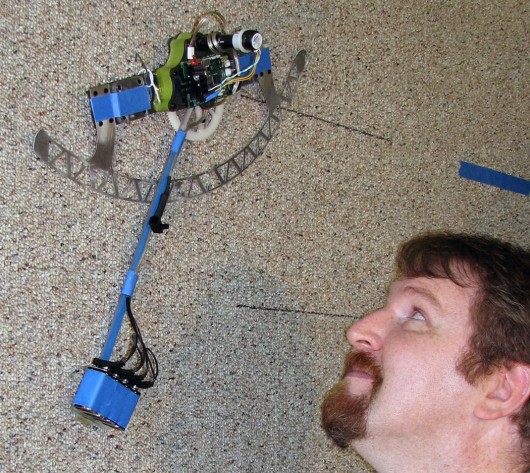
First wall-climbing robot to focus on climbing efficiently
Engineers have used a variety of techniques to create robots that can scale walls – “the Climber” uses a rolling seal, while the insect-like robots from SRI have caterpillar tracks with electro-adhesive properties. While such robots generally focus on speed, adhering to the wall and deciding how and when to move, the creators of a small robot named ROCR say it is the first wall-climbing robot to focus on climbing efficiently. And it does so by using the momentum of a tail that swings like a grandfather clock’s pendulum.
The ROCR Oscillating Climbing Robot was developed by William Provancher, an assistant professor of mechanical engineering at the University of Utah. It is small and lightweight – only 12.2-inches wide, 18-inches long from top to bottom and weighing only 1.2 pounds – and is designed to climb efficiently by moving like human rock climbers or apes swinging through trees. This mimicry allows ROCR to scramble up a carpeted eight-foot wall in just over 15 seconds.
Other wall-climbing robots can ascend faster than ROCR, which can climb at 6.2-inches per second. However, none have been able to achieve the 20 percent efficiency in climbing tests that ROCR has managed, “which is relatively impressive given that a car’s engine is approximately 25 percent efficient,” Provancher says. Provancher defines the robot’s efficiency as the ratio of work performed in the act of climbing to the electrical energy consumed by the robot.
Building a more efficient robot
ROCR is self-contained and autonomous, with a microcomputer, sensors and power electronics to execute desired tail motions to make it climb. The motor that drives the robot’s tail and a curved, girder-like stabilizer bar attach to the robot’s upper body. The upper body also has two small, steel, hook-like claws to sink into a carpeted wall as the robot climbs. Without the stabilizer, ROCR’s claws tended to move away from the wall as it climbed and it fell.
The motor drives a gear at the top of the tail, causing the tail to swing back and forth, which propels the robot upward. A battery is at the end of the tail and provides the mass that is necessary to swing the robot upward. ROCR grips the wall with one hand at a time and swings its tail. This causes a shift in ROCR’s center of gravity that raises its free hand, which then grips the wall and the process repeats.
“It pursues this goal of efficiency with a design that mimics efficient systems both in nature and manmade,” Provancher says. “It mimics a gibbon swinging through the trees and a grandfather clock’s pendulum, both of which are extremely efficient.”
Provancher and his team decided to focus on wall climbing efficiency because, now that various methods have been tried and proven for robots to climb a variety of wall surfaces, for such robots to have both versatility and mission life, “efficiency rises to the top of the list of things to focus on,” he says.
Related articles by Zemanta
- Robot Climbs Walls (usnews.com)
- New Robot Climbs Walls Like an Ape Going Up a Tree (livescience.com)
- Fun Robot Stuff: Roomba Revenge and My Robot Nation (spectrum.ieee.org)
- ‘Gecko robot’ walks up walls (blogs.nature.com)









